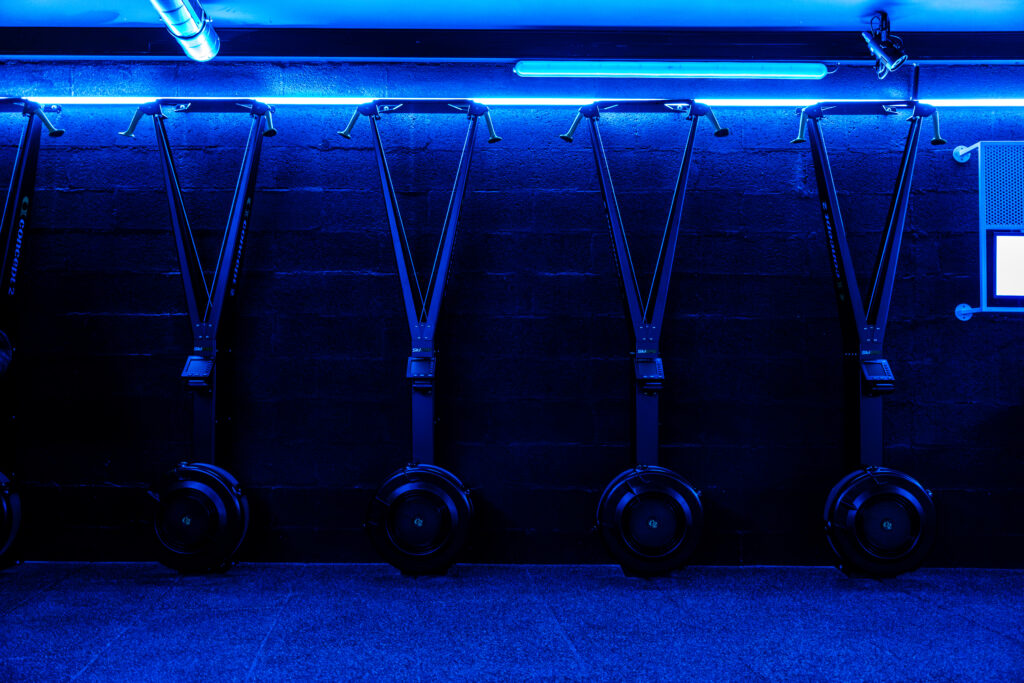
Summary
Welcome / Welcome / Tips for getting started / HYROX Sled Push: everything you need to know about this flagship station
HYROX Sled Push: everything you need to know about this flagship station
If you are preparing for a competition HYROX or are simply curious about this demanding event, you should know that the Sled Push is one of the most popular intense and important aspects of the event. HYROX combines 8 kilometre run with 8 functional exercise stationsAnd the Sled Push puts your strength, endurance and technique to the test.
This station involves pushing a heavy sled over a distance of 50 metresThis is a real challenge for the athletes, whether in the Men's Pro, Women's Pro, Open or Doubles divisions.
Whether you're new to fitness or experienced, master the Sled Push is essential to optimise your performance. In this article, discover the rules, the challenges, the ideal technique and tips on how to excel in a HYROX competition.
Summary
Introduction to Sled Push Hyrox
THE Sled Push is one of the most popular demanding and strategies as part of a HYROX event. This event, which involves pushing a heavy sled over a distance of 50 metres, is the first of its kind in the world. second station encountered by athletes during competition. It lies between the Sled Pull and the Burpee Broad Jumps.
In the context of a HYROX, where participants alternate between 1 kilometre of running and 8 functional exercise stations, the Sled Push plays an important role. It tests the strength, l'endurance and the technique athletes. This station is not only a physical ordeal, but also a mental challenge that can have a significant impact on the overall performance of the athlete throughout the race.
The Sled Push varies in weight depending on the category of athlete. Women in the Open have to push a sled of 102 kgcategory, while those in the Pro have to manage a weight of 152 kg.
For men, the weights are respectively 152 kg for the Open category and 202 kg for the Pro category.
Although simple in concept, this station requires a preparation and an specific techniques to be carried out optimally. Understanding the rules, THE standards and the techniques involved in the Sled Push is essential for anyone preparing for this challenge.
What is the Sled Push in HYROX?
THE Sled Push is one of the key stations and the most demanding at a HYROX event. This event involves pushing a heavy sled over a precise distance of 50 metresdivided into four sections of 12.5 metres each.
In a HYROX, where participants alternate between 1 kilometre run And 8 functional exercise stationsthe Sled Push is the second station This event, which is between the Sled Pull and the Burpee Broad Jumps, is one of the most challenging in the world. Although the concept is simple - to push a sled over a carpeted surface - this event requires a great deal of skill. large force and an appropriate technique to be carried out effectively.
The weight of the sled varies according to the category of participants:
- For women in the Openthe total weight is 102 kgincluding the sleigh.
- Women in the Pro have to manage a weight of 152 kg.
- For men, the weights are respectively 152 kg for the Open category and 202 kg for the Pro category.
- The categories Double And Relay also have specific weights, ranging from 102 kg has 152 kgdepending on the composition of the team.
The station must be completed in its entirety to avoid penalties. If the athlete does not manage to cover the 50 metres in the allotted time, a 3-minute penalty per missing section will be applied. It is therefore essential to understand the rules and the standards to avoid these penalties and optimise its performance.
Official HYROX Sled Push Rules and Standards
Organisation of the station
Each athlete is assigned to a sled track by the team of judges. It is imperative that the athlete uses the lane allocated to him/her. Failure to comply with this rule will result in a time penalty.
Before starting, the sled and the athlete must be completely behind the starting line. This provision guarantees equality and security for all participants.
Distances and length distribution
There total distance for the Sled Push is 50 metresThe course is divided into four sections of 12.5 metres each. The athlete must push the sled so that it fully exceeds the 12.5 metre mark before changing direction.
The station is considered to be completed when the athlete has completed all four sections and the sled has completely crossed the start/finish line.
Sled weights by category
THE weight of sleds vary according to the category of athlete:
- For women in the Openthe total weight is 102 kg (including the sleigh).
- Women in the Pro have to manage a weight of 152 kg.
- For men, the weights are respectively 152 kg for the Open category and 202 kg for the Pro category.
The categories Double And Mixed also have specific weights, ranging from 102 kg to 152 kg depending on the composition of the team.
Penalty rules
If the athlete fails to complete the four 12.5-metre sections, a 3-minute penalty per missing section will be applied. In addition, any violation of the rulesfailure to stay behind the starting line or to respect the distance markers will result in the following penalties time penalties determined by the Chief Justice.
He is essential that the athletes raise their arm to call a judge in order to confirm completion of the required distance before leaving the station. This ensures that the station is validated correctly and avoids any unjustified penalty.
The specific challenges of the HYROX Sled Push
Why is the Sled Push so difficult?
THE Sled Push in a HYROX event involves a number of specific challenges that make it particularly demanding for the athletes. One of the main reasons for this is the surface on which the sled is to be pushed.
The carpet used at HYROX events is often very sticky and uneven, which makes it much harder to work on than the smooth surfaces found in gymnasiums.
What's more, this carpet has a tendency to become pleat and crumple during exercise, increasing resistance and making the movement even more arduous. The irregularity of the surface can vary from event to event, forcing athletes to adapt quickly to the specific conditions of the race.
Another major challenge is the abrupt transition from thecardiovascular endurance and the sheer force. The Sled Push follows a 2-kilometre run and a ski ergometer. 1 kilometre. This means that athletes have to make the transition from a predominantly aerobic activity to a task requiring great strength and explosive power. This transition is particularly difficult to manage, especially if the athlete has not trained sufficiently in this area.
There fatigue also plays a key role. Pushing a heavy sled for 50 metres can quickly exhaust the legs, which has a direct impact on performance for the rest of the event.
If an athlete pushes himself too hard too early on the Sled Push, he risks compromising his overall time and its ability to efficiently complete subsequent stations.
Finally, errors of technique and strategy can make the Sled Push even more difficult. Mistakes such as strides that are too long, a lack of core commitment or wearing inappropriate footwear can slow the athlete down considerably and increase fatigue. It is therefore essential to practise and perfect your technique to avoid these errors and maximise performance.
Technique and positioning: How to optimise your Sled Push?
Body and hand position
For maximise your performance in the Sled Push, the position of the body and hands is essential. Stand close to the sled with your feet hip-width apart. This position gives you better control and optimum power.
You have several options for placing your hands on the sled handles. One method is to use bent arms, with your hands gripping the handles firmly and your elbows in line with your shoulders. This allows a power transfer efficient.
Another option is to use outstretched arms, but this technique is often not recommended as it can lead to excessive shoulder fatigue.
Body positioning is also essential. Tilt your body forward while maintaining a straight line from your head to your heels. This posture engages your core and helps keep your centre of gravity forward, adding more power to your push.
Key points for an effective push
The push-up technique starts with a solid starting position. Engage your leg muscles - quadriceps, glutes and calves - and initiate the push with a powerful impetus. Concentrate on propelling through the heels to maximise your strength.
The first push must be strong and deliberate to set the sled in motion.
After this initial push, opt for shorter, faster steps to maintain your momentum. momentum of the sled. Keep your body low and tilted forward, pushing continuously with your legs.
Maintain a steady pace and avoid stopping, as restarting the sled requires much more energy.
Your arms and upper body play a key role in stabilising and steering the sled. Keep your arms bent or straight, depending on your preference. preferenceand use your upper body to guide the sled along the desired path.
Adopt an appropriate breathing pattern: breathe in before you push and breathe out during the effort. This helps maintain your rhythm and endurance.
Common mistakes to avoid
For optimum performance and to avoid injury, it's important to be aware of common mistakes. One common mistake is to keep your arms fully extended, which can lead to excessive shoulder and back strain. It's better to use bent arms or position them around the handles to distribute the load evenly.
Another mistake is neglecting posture. Poor posture or incorrect positioning of the feet can increase the risk of injury. Practise the technique regularly to develop muscle memory and boost your confidence in movement.
Finally, avoid stopping during the push. Restarting the sled requires a lot more energy. Maintain a constant momentum is essential for successful performance.
Physical preparation and specific training Sled Push
Targeted muscle strengthening
To excel at Sled PushIt is essential to work on the muscle strengthening of the key groups involved in this event. The legs, hips and back play a central role. Here are a few essential exercises to incorporate into your training routine:
Heavy squats and deadlifts : These exercises build overall leg and back strength, which are essential for pushing the sled. Heavy squats, particularly front squats and the back squatsThese target the quadriceps and glutes, while deadlifts with the trap bar effectively develop the posterior chain.
Bulgarian split squats : These unilateral exercises improve both leg strength and stability. They are particularly useful for Sled Pushwhich is based on a series of unilateral attacks.
Step-ups and farmer's carry : Step-ups increase power and leg strength, while farmer's carries improve grip and stability. core under load.
Practising sled push in real-life conditions
Practice Sled Push in conditions close to competition is essential to optimise your preparation. This means training on a similar surface, often a very sticky, uneven carpet.
If you don't have access to such a surface, you can simulate friction by adding weight to the sled or using a surface that offers more resistance.
To maximise your preparation, use loads equivalent to or greater than those for the competition. For example, if you have to push a sledge of 152 kg at the event, train with at least this weight to familiarise yourself with the effort required.
Getting used to exertion under fatigue
THE Sled Push often comes after running and other exercise, which means you'll already be tired going into the event. To prepare yourself, include some compromised training in your programme.
An effective example: go for a run of 500 metres at a slightly faster rate than your usual pace, immediately followed by a Sled Push 30 metres at running weight. Repeat this circuit for 4 rounds, with no rest between sets.
This training will help you develop the ability to maintain your performance under fatigue, a key skill for success not only in the Sled Pushas well as all the event's events HYROX.
Benefits of the Sled Push beyond competition
THE Sled Push offers a host of benefits that go far beyond a HYROX competition or any other sporting event. Here's why this exercise is a excellent addition to any fitness programme:
Developing strength and power
THE Sled Push is a versatile exercise that involves many muscle groups, including the legs, buttocks, shoulders, arms and abdominal muscles. This exercise encourages the development of strength and some powerThis is beneficial for improving performance in various sporting activities and in everyday life.
Improved cardiovascular endurance
This type of exercise is also an excellent tool for improving cardiovascular endurance. The Sled PushThanks to its high intensity, it increases heart rate and improves aerobic capacity. This makes daily activities less tiring and strengthens the immune system. overall health the heart and lungs.
Burning calories and weight management
THE Sled Push is an intense exercise that burns a significant number of calories, making it ideal for those looking to lose weight or maintain a healthy body composition. By incorporating this exercise into a training programme HIIT (High Intensity Interval Training)You can speed up your metabolism and promote fat loss.
Injury prevention and rehabilitation
Unlike many strength exercises, the Sled Push has a relatively low impact on the joints. This makes it a safe choice for those recovering from injury or looking to prevent future injury. By strengthening the muscles around the joints and promoting a more balanced, healthy workout, it is a safe choice for those recovering from injury or looking to prevent future injury. muscular balanceThis exercise significantly reduces the risk of injury.
Versatility and adaptability
One of the main advantages of Sled Push lies in its versatility. This exercise can be easily adapted to all fitness levels by adjusting the weight of the sled and the distance to be covered.
Whether you're a beginner or an experienced athlete, you can modify the intensity and resistance so that the exercise perfectly matches your objectives and your level of fitness. fitness.
By regularly integrating the Sled Push to your training routine, you can see a marked improvement in your overall fitness. Benefits include an increase in strength and some muscular powerThe result is improved cardiovascular endurance and optimised weight management. This makes it an excellent addition to any fitness programme, whatever your goals or level of fitness.
Our advice
Plan your break strategy (anticipate rather than suffer)
A a well-planned break strategy is essential to optimise your Sled Push performance. Avoid going all out without thinking, as this can lead to a premature fatigue. It's important to allow time for active recovery, particularly after completing each 12.5-metre section.
Take a few seconds to catch your breath and adjust your position before continuing. This will enable you to maintain a steady rhythm and avoid sudden stops, which are often costly in terms of time and energy.
Managing the adrenalin at the start to avoid speeding
The adrenalin at the start can be intense, but it's important to harnessing this energy to avoid setting off too quickly. If you start too quickly, you risk using up a lot of your energy in the first few metres, which could leave you exhausted for the rest of the station.
Start with a powerful but controlled thrust to break the inertia of the sled. Next, stabilise your pace by taking short, fast steps. This approach will help you maintain a constant speed and avoid burning out too soon.
What to do if the carpet wrinkles or resistance increases
The surface of the carpet on which you push the sled can sometimes wrinkle or become more resistant, slowing down your progress. If this happens, it is important to stay calm and adapt quickly.
If the mat wrinkles, try to straighten it quickly with your foot while continuing to push. If the resistance increases, adjust your technique by leaning forward slightly and using more strength in your legs to keep the mat straight. momentum. Avoid coming to a complete stop, as restarting the sled requires much more energy than continuing to push despite increased resistance.
Conclusion
In conclusion Sled Push in a HYROX event is both an event demanding And rewardingwhich requires a combination of strength, ofendurance and of technique. To succeed, it is essential to have a good understanding of the official rules and standardscontrol the pushing technique and train specifically for this station.
A targeted physical preparationadaptation to real conditions and optimum fatigue management are key to improving your performance.
Don't underestimate the impact of the surface and conditions of the event on your results. It is advisable to practise with different types of sleds and on various surfaces to prepare you for possible variations.
Finally, carefully plan your break strategy and manage your adrenaline to maintain a steady pace and avoid premature fatigue.
Incorporate these tips into your training routine now. With a adequate preparation and a good techniqueyou'll be ready to face the Sled Push with confidence and maximise your chances of success at your next HYROX competition.
FAQs
How heavy is a HYROX Sled Pull?
The weight of a Sled Pull in HYROX depends on the category:
- Women : 78 kg (incl. sled)
- Pro Women : 103 kg (incl. sled)
- Men: 103 kg (incl. sled)
- Men's Pro : 153 kg (incl. sled)
- Mixed Doubles : 103 kg (incl. sled)
- Women's Doubles : 78 kg (incl. sled)
- Men's Doubles : 103 kg (incl. sled)
- Relay : 78 kg / 103 kg (F/H, incl. sled)
What is the empty weight of a Sled Push?
The empty weight of a Sled Push varies according to model and brand. In general, an unloaded sled push weighs between 20 and 50 kgbut this can vary significantly.
For example, the Nike Weight Sled has a load capacity of 500 lb, but its empty weight is not specified in the available sources.
How heavy is a Sled Push?
The weight of a Sled Push in events like HYROX varies according to category:
- Women : 102 kg (incl. sled)
- Pro Women : 152 kg (incl. sled)
- Men: 152 kg (incl. sled)
- Men's Pro : 202 kg (incl. sled)
- Mixed Doubles : 152 kg (incl. sled)
- Women's Doubles : 102 kg (incl. sled)
- Men's Doubles : 152 kg (incl. sled)
- Relay : 102 kg / 152 kg (F/M, incl. sled)
How do I make a sled push?
To make a Sled Pushfollow these steps:
- Stand behind the sled with your feet shoulder-width apart and your toes pointing forward.
- Bend your knees slightly and Tilt your hips to lower your body while keeping your back straight.
- Grip the sled handles firmly with both hands.
- Engage your core to stabilise your spine and push the sled using the strength of your legs.
- Take short, quick steps to maintain speed and momentum.
- Avoid bending or arching your back, and keep a steady pace.
Share
Tagged
Read also
follow us
on instagram
To follow all our news,
take advantage of our tutorials and participate
in our many competitions.
BREAKING NEWS!
Receive our newsletter.




